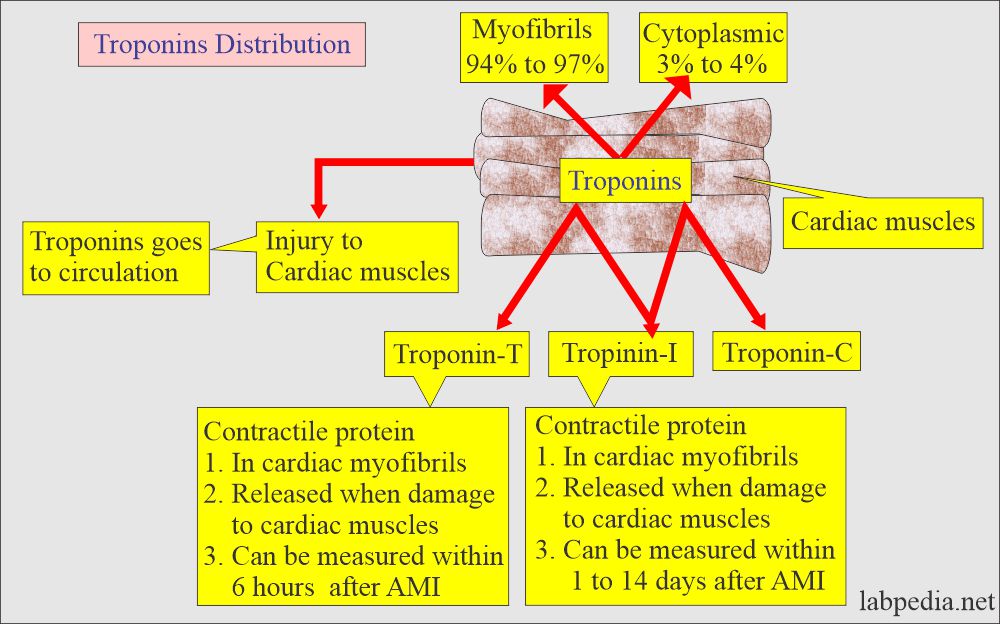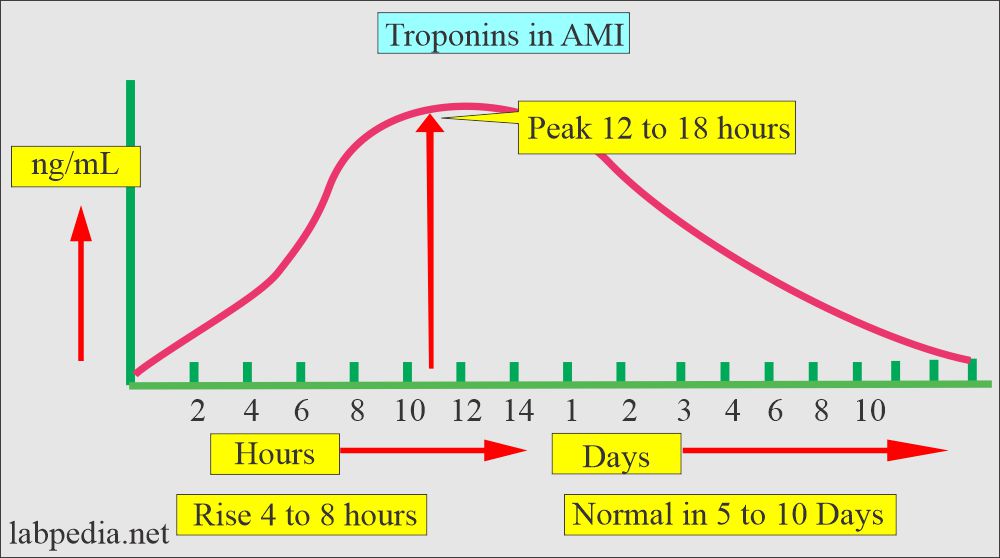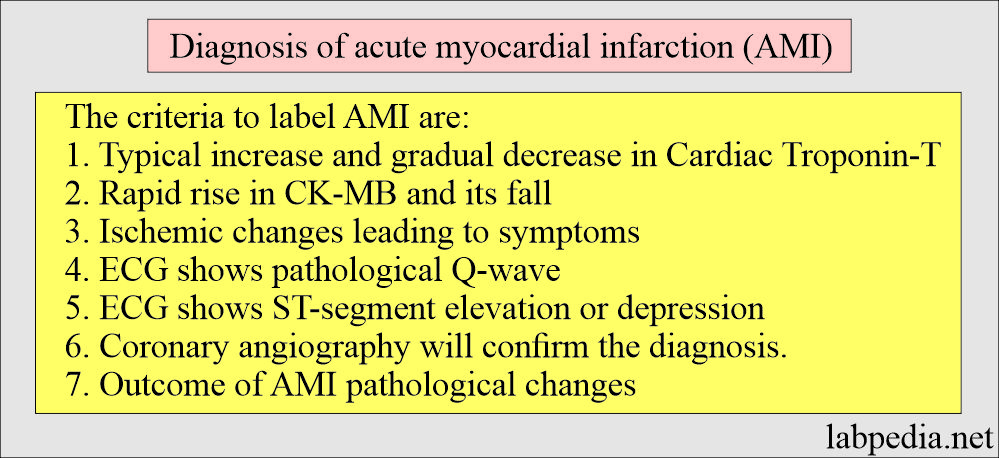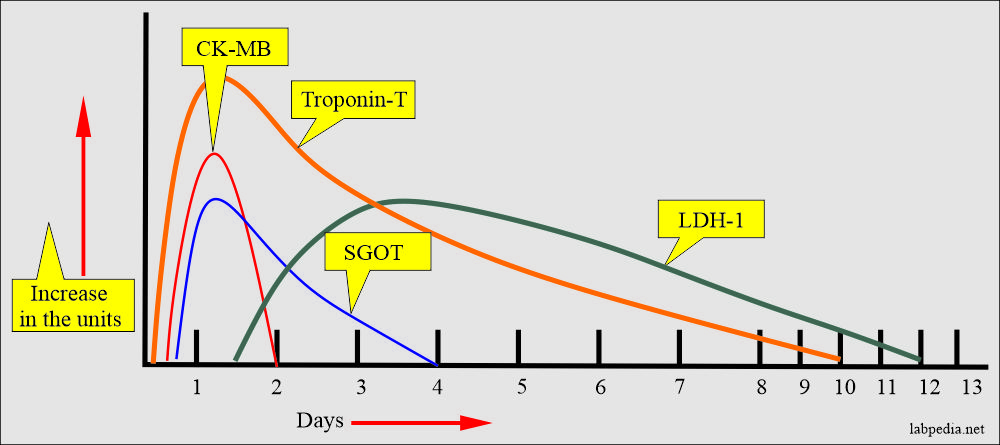Cardiac Marker:- Part 3 -Troponin-T, and Troponin-I
Troponin-T, and Troponin-I
Sample for Troponin-T and Troponin-I
- It is done on the EDTA blood.
- This test can also be done in the serum or plasma.
- A serial sample may be needed.
- The serum for troponin-T is stable for 24 hours at 2 to 8 °C.
- Can store serum for three months at -20 °C.
Indications for Troponin-T and Troponin-I
- This test is advised to rule out myocardial infarction (MI) in a patient with chest pain.
- This is a specific indicator of cardiac damage or infarction.
- This helps diagnose MI at an early stage.
- This test is done for the early diagnosis of myocardial infarction.
Definition of troponins:
- Troponins are contractile proteins found within muscle fibers that help regulate contractions.
- Three troponins work as complex.
- Troponin-T = Tropomyosin-binding component.
- Troponin-I = Inhibitory component.
- Troponin-C = Calcium-binding component.
- During muscle necrosis, Troponin-T and Troponin-I are released into blood circulation.
- Troponin-T and Troponin-I levels in the blood increase, indicating muscle necrosis.
- Troponins are not raised in angina.
Pathophysiology of Troponin-T and Troponin-I
- Troponins are proteins present in the skeletal and cardiac muscles.
- Troponins have three subunits complex:
- It will regulate the interaction of actin and myosin.
- These reactions of actin and myosin regulate cardiac contraction.
- These are regulatory proteins.
- Troponin is a complex of :
- Troponin-C is a Ca-binding component.
- It is not advised in AMI because this is not specific for myocardial muscles.
- Troponin-I is an inhibitory component.
- Troponin-T is a tropomyosin-binding component.
- Troponin-C is a Ca-binding component.
- Troponins are present in myofibrils around 94% to 97%.
- Troponin cytoplasmic fraction is 3% to 6%.
Troponins and muscle injury:
- There are kits for Troponin-I, but because of its three forms in circulation and their variation in concentration, different assays don’t produce reproducible results.
- Troponins remain in the blood circulation from 1 to 14 days after the onset of AMI.
- Troponin-T has no cross-reactivity with skeletal muscle, so this assay is 100 % specific for cardiac disease.
- Troponins help in the contraction of muscles, which is calcium-dependent, and there is an interaction between myosin and actin.
- There are two cardiac troponins:
- Troponin-T.
- Troponin-I.
- These are highly specific for cardiac muscle injury.
- Their role is just like CK-MB.
- Troponins are more specific than CK-MB.
- Troponins will be nearly normal or slightly raised in noncardiac muscle injuries.
Advantages of troponins:
- There is a quick release of troponins after the cardiac muscle injury (necrosis).
- These are present for a longer period of time after the heart attack.
- Troponins are measured by:
- Monoclonal antibody immunoassay.
- Enzyme-linked immunoassay.
- Monoclonal sandwich antibody qualitative technique.
Troponin and CK-MB difference:
| Causative reason | Troponin-T | CK-MB |
|---|---|---|
| Skeletal muscle injury | Normal | Raised |
| Brain / Lung injury | Normal | Raised |
| Cardiac injury | Raised | Raised |
| Duration | Raised for a longer time | raised for a shorter time |
| Sensitivity | More sensitive | Less sensitive |
Advantage of Troponin over CK-MB:
| Characteristic feature | Troponins | CK-MB |
| Specificity |
|
|
| Increased level |
|
|
| Sensitivity |
|
|
| Importance |
|
|
Normal Troponin-T, and Troponin-I
Source 1
- Cardiac Troponin-T = < 0.2 ng/mL
- Cardiac Troponin-I = < 0.03 mg/mL
Source 2
- Troponin-T = 0 to 0.1 µg/L
- Troponin-I = <3.1 µg/L
Source 3
- Troponin I = <0.35 ng/mL
- Or <0.35 µg/L
- Troponin T = <0.2 ng/mL
- Or <0.2 µg/L
The pattern of Troponin-T in acute myocardial infarction:
- Raised even in the first 3 hours.
- The peak level is 12 to 48 hours.
- Remain elevated for up to 10 to 14 days.
Troponins interpretations:
- Raised Troponin-T level establishes the diagnosis of AMI; even ECG or CK-MB is non-diagnostic (<50% of the cases).
- It indicates irreversible necrosis of the myocardial muscles.
- Serial troponin-T level normal rules out the possibility of myocardial necrosis (AMI).
- Troponins have replaced the CK-MB as the gold standard, replacing late diagnosis of AMI with the raised level of LDH.
- Troponin-T is as sensitive as CK-MB in the first 48 hours of the onset of AMI. It is >85% in concordance with CK-MB.
- Troponin-T sensitivity during 0 to 2 hours after the onset of chest pain = 33%
- Troponin-T sensitivity during 2 to 4 hours after the onset of chest pain = 50%.
- Troponin-T sensitivity during 4 to 8 hours after the onset of chest pain = 75%.
- Troponin-T sensitivity after 8 hours of the onset of chest pain = 100%.
- Troponin-I is 13 times more abundant in the myocardium than CK-MB, providing.
- Troponin-I remained increased for <9 days, while Troponin-T was for 14 days.
- Troponins are increased in <50% of patients with acute pericarditis.
- A level of troponins <0.5 ng/mL indicates no myocardial damage.
- >2.0 ng/mL indicates some myocardial necrosis.
Universal definition of acute myocardial infarction:
- The Troponin value of at least one of these is >99% of the normal.
- The rapid rise in CK-MB and falls to normal.
- Evidence of the ischemia.
- Prominent Q-wave.
- Elevation of ST-segment.
Positive or raised Troponin-I level seen in:
- Myocardial injury during surgery.
- Small myocardial infarcts can be detected for up to 7 to 10 days.
Positive or raised Troponin-T level was seen in:
- Acute myocardial infarction.
- Pre-Surgical myocardial infarction.
- Unstable angina.
- Non-ischemic diseases of the heart:
- Acute trauma involving muscles.
- Rhabdomyolysis.
- Polymyositis.
- Dermatomyositis.
- Chronic renal failure.
- Myocarditis.
- Pericarditis.
- Heart failure.
- Pulmonary embolism.
- Sepsis.
- Shock.
- Renal insufficiency.
Cardiac markers:
| Markers | Detectable | Peak level | Return to normal |
|---|---|---|---|
| Troponin-T | 4 to 8 hours | 12 to 48 hours | 7 to 10 days |
| Troponin- I | 4 to 6 hours | 12 hours | 3 to 10 days |
| CK-MB | 4 to 8 hours | 12 to 24 hours | 72 to 96 hours |
| LDH | 2 to 5 days | 10 days |
Questions and answers:
Question 1: What is the significance of the CK-MB for AMI?
Question 2: What is the distribution of troponins in the cell cytoplasm?




